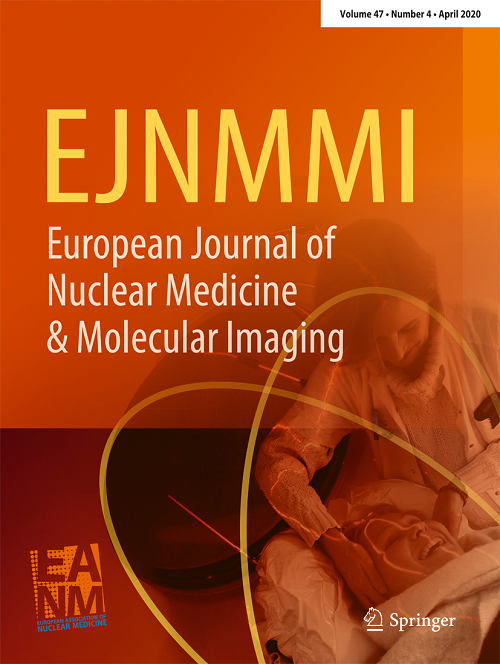Baseline [18F]FDG PET/CT characterization of extramedullary disease and prognostic value in relapsed/refractory B-cell acute lymphoblastic leukemia treated with CAR-T cells.
IF 7.6
1区 医学
Q1 RADIOLOGY, NUCLEAR MEDICINE & MEDICAL IMAGING
European Journal of Nuclear Medicine and Molecular Imaging
Pub Date : 2025-09-20
DOI:10.1007/s00259-025-07562-y
引用次数: 0
Abstract
PURPOSE This study aimed to characterize the non-central nervous system extramedullary disease (non-CNS EMD) in patients with relapsed/refractory B-cell acute lymphoblastic leukemia (r/r B-ALL) and to evaluate the prognostic value of metabolic parameters derived from [18F]FDG PET/CT imaging. METHODS Patients with r/r B-ALL who received chimeric antigen receptor (CAR)-T cell therapy and underwent [18F]FDG PET/CT before CAR-T cell therapy were retrospectively enrolled. Lesions were semi-automatically segmented using LIFEx software, based on a threshold of 41% of the maximal uptake value. The anatomical locations of FDG-avid lesions were summarized to delineate the characteristics of non-CNS EMD. Furthermore, metabolic parameters from FDG PET/CT (SUVmax, MTV, and TLG) as well as selected clinical and laboratory features were collected. These variables were categorized into two groups for survival analysis. Progression-free survival (PFS) and overall survival (OS) were estimated using the Kaplan-Meier method. RESULTS A total of 81 B-ALL patients were included in this study. The most frequently observed non-CNS EMD lesions involved the lymph node, spleen, and kidney. After a median follow-up time of 23.7 months, multivariate analysis identified hemoglobin (Hb) and SUVmax (with a cut-off value of 7.0) as independent prognostic factors for PFS and OS. Patients with abnormal Hb levels exhibited significantly shorter PFS and OS compared to those with normal Hb levels (median PFS: 13.5 months vs. not reached, P = 0.004; median OS: 48.0 months vs. not reached, P = 0.010). Similarly, patients with SUVmax above the threshold had significantly reduced PFS and OS compared to those below the threshold (median PFS: 9.1 months vs. not reached, P ≤ 0.001; median OS: 27.0 months vs. 50.8 months, P = 0.020). CONCLUSION [18F]FDG PET/CT effectively visualizes extramedullary infiltration in patients with B-ALL, and these non-CNS EMD lesions were also associated with clinical outcomes. SUVmax serves as a valuable predictive biomarker for both PFS and OS.[18F] CAR-T细胞治疗复发/难治性b细胞急性淋巴细胞白血病髓外疾病的FDG PET/CT特征及预后价值。
目的本研究旨在对复发/难治性b细胞急性淋巴细胞白血病(r/r B-ALL)患者的非中枢神经系统髓外病变(non-CNS EMD)进行表征,并评估[18F]FDG PET/CT成像代谢参数的预后价值。方法回顾性纳入接受CAR-T细胞治疗并在CAR-T细胞治疗前接受FDG PET/CT检查的r/r B-ALL患者。基于最大摄取值的41%的阈值,使用LIFEx软件对病变进行半自动分割。总结了FDG-avid病变的解剖位置,以描述非中枢神经系统EMD的特征。此外,收集了FDG PET/CT (SUVmax, MTV和TLG)的代谢参数以及选定的临床和实验室特征。这些变量被分为两组进行生存分析。使用Kaplan-Meier法估计无进展生存期(PFS)和总生存期(OS)。结果本研究共纳入81例B-ALL患者。最常见的非中枢神经系统EMD病变包括淋巴结、脾脏和肾脏。中位随访时间为23.7个月后,多变量分析确定血红蛋白(Hb)和SUVmax(临界值为7.0)是PFS和OS的独立预后因素。与Hb水平正常的患者相比,Hb水平异常的患者表现出明显较短的PFS和OS(中位PFS: 13.5个月vs未达到,P = 0.004;中位OS: 48.0个月vs未达到,P = 0.010)。同样,SUVmax高于阈值的患者与低于阈值的患者相比,PFS和OS显著降低(中位PFS: 9.1个月vs.未达到,P≤0.001;中位OS: 27.0个月vs. 50.8个月,P = 0.020)。结论[18F]FDG PET/CT能有效显示B-ALL患者的髓外浸润,这些非中枢神经系统EMD病变也与临床预后相关。SUVmax可作为PFS和OS的有价值的预测性生物标志物。
本文章由计算机程序翻译,如有差异,请以英文原文为准。
求助全文
约1分钟内获得全文
求助全文
来源期刊
CiteScore
15.60
自引率
9.90%
发文量
392
审稿时长
3 months
期刊介绍:
The European Journal of Nuclear Medicine and Molecular Imaging serves as a platform for the exchange of clinical and scientific information within nuclear medicine and related professions. It welcomes international submissions from professionals involved in the functional, metabolic, and molecular investigation of diseases. The journal's coverage spans physics, dosimetry, radiation biology, radiochemistry, and pharmacy, providing high-quality peer review by experts in the field. Known for highly cited and downloaded articles, it ensures global visibility for research work and is part of the EJNMMI journal family.

 求助内容:
求助内容: 应助结果提醒方式:
应助结果提醒方式:


